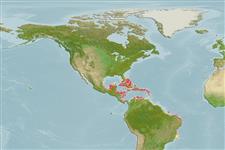Environment / Climate / Range
Ecology
Marine; reef-associated; depth range 1 - 8 m (Ref. 51183). Tropical, preferred ?
Western Central Atlantic: Bahamas (Ref. 5521), Virgin Islands (Ref. 26180), Belize, Honduras, and Colombia (Ref. 26280). Also Navassa Island (Ref. 50108).
Size / Weight / Age
Maturity: Lm ? range ? - ? cm
Max length : 2.5 cm TL male/unsexed; (Ref. 5521)
Short description
Morphology | Morphometrics
Dorsal
spines
(total): 18 - 19;
Dorsal
soft rays
(total): 7-8;
Anal
soft rays: 15 - 16;
Vertebrae: 31 - 33. Dark blotches on trunk often arranged in 2 or 3 horizontal tiers; pale gap between 2 blotches of darker pigment on pectoral-fin base with wavy margins; cheek with irregular horseshoe-shaped blotch of pigment; no streak of dark pigment along distal edge of preopercle.
Inhabits coral reefs.
Life cycle and mating behavior
Maturity | Reproduction | Spawning | Eggs | Fecundity | Larvae
Böhlke, J.E. and C.C.G. Chaplin, 1993. Fishes of the Bahamas and adjacent tropical waters. 2nd edition. University of Texas Press, Austin. (Ref. 5521)
IUCN Red List Status (Ref. 115185)
CITES (Ref. 94142)
Not Evaluated
Threat to humans
Harmless
Human uses
More information
Common namesSynonymsMetabolismPredatorsEcotoxicologyReproductionMaturitySpawningFecundityEggsEgg development
Age/SizeGrowthLength-weightLength-lengthLength-frequenciesMorphometricsMorphologyLarvaeLarval dynamicsRecruitmentAbundance
ReferencesAquacultureAquaculture profileStrainsGeneticsAllele frequenciesHeritabilityDiseasesProcessingMass conversion
Tools
Special reports
Download XML
Internet sources
Estimates of some properties based on models
Phylogenetic diversity index (Ref.
82805): PD
50 = 0.5000 [Uniqueness, from 0.5 = low to 2.0 = high].
Bayesian length-weight: a=0.00468 (0.00183 - 0.01196), b=3.10 (2.87 - 3.33), in cm Total Length, based on LWR estimates for this (Sub)family-body shape (Ref.
93245).
Trophic Level (Ref.
69278): 3.1 ±0.4 se; Based on size and trophs of closest relatives
Resilience (Ref.
69278): High, minimum population doubling time less than 15 months ().
Vulnerability (Ref.
59153): Low vulnerability (10 of 100) .
